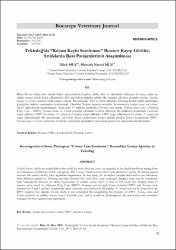| dc.contributor.author | Muz, Dilek | |
| dc.contributor.author | Muz, Mustafa Necati | |
| dc.date.accessioned | 2022-05-11T14:42:19Z | |
| dc.date.available | 2022-05-11T14:42:19Z | |
| dc.date.issued | 2017 | |
| dc.identifier.issn | 1308-1594 | |
| dc.identifier.issn | 2147-6853 | |
| dc.identifier.uri | https://app.trdizin.gov.tr/makale/TWpRME9EYzJOZz09 | |
| dc.identifier.uri | https://hdl.handle.net/20.500.11776/9333 | |
| dc.description.abstract | Dünya'da on yıldan fazla süredir dikkat çeken koloni kayıpları, farklı etken ve faktörlerin etkileşimi ile ortaya çıkan arı sağlığı sorunu olarak kabul edilmektedir. Bal arısı koloni sağlığını tehdit eden hastalık etkenleri arasında viruslar, Nosema ceranae ve Varroa destructor ciddi öneme sahiptir. Bu çalışmada 2015 ve 2016 yıllarında Tekirdağ ilindeki farklı arılıklardan gönderilen balarısı numuneleri incelenmiştir. Örnekler "koloni populasyonundaki beklenmeyen azalma veya ani koloni kaybı" şikâyetleriyle gönderilmiştir. Buna göre 17 arılıktan gönderilen 510 bal arısı örneği, Deforme kanat virusu (Deformed Wing Virus - DWV), Nosema cerenae ve Varroa destructor yönünden kontrol edilmiştir. Bu arılıkların tamamında varroosis tespit edilirken, DWV 15 arılıkta, N. ceranae ise 5 arılıkta tespit edilmiştir. DWV tespit edilemeyen iki arılıkta N. ceranae da tespit edilememiştir. Bu araştırmada, ani koloni kaybı sendromuna benzer şekilde görülen koloni kayıplarında DWV, Nosema cerena ve Varroa destructor'a rastlanma oranlarının araştırılarak bu konuda güncel veri sağlanması hedeflenmiştir. | en_US |
| dc.description.abstract | Colony losses, which are remarkable in the world for more than ten years, are regarded as bee health problems arising from the interaction of different factors and agents. The viruses, Nosema ceranae and Varroa destructor among the disease agents threaten the colony health, have significant importance. In this study, the honeybee samples delivered to our laboratory from different apiaries in Tekirdağ province between 2015 and 2016, were examined. Samples were sent by complaints with "unexpected decrease in colony populations or sudden colony loss". A total of 510 honey bee samples from 17 apiaries were tested for Deformed Wing Virus (DWV), Nosema cerenae and Varroa destructor. DWV and N.cerena were detected in 15 and 5 apiaries, respectively while varroosis was detected in all apiaries. N. ceranae was not be detected in the DWV negative two apiaries. In this study, it was concluded that considering the presence of DWV, Nosema cerena and Varroa destructor in sudden colony losses resemble case, and it would be advantageous the precaution and treatment strategies for bees against these pathogens. | en_US |
| dc.language.iso | tur | en_US |
| dc.rights | info:eu-repo/semantics/openAccess | en_US |
| dc.subject | Veterinerlik | en_US |
| dc.title | Tekirdağ'da "Koloni Kaybı Sendromu" Benzeri Kayıp Görülen Arılıklarda Bazı Patojenlerinin Araştırılması | en_US |
| dc.title.alternative | Investigation of Some Pathogens "Colony Loss Syndrome" Resembled Losses Apiaries in Tekirdağ | en_US |
| dc.type | article | en_US |
| dc.relation.ispartof | Kocatepe Veterinary Journal | en_US |
| dc.department | Fakülteler, Veteriner Fakültesi, Klinik Öncesi Bilimler Bölümü, Parazitoloji Ana Bilim Dalı | en_US |
| dc.identifier.volume | 10 | en_US |
| dc.identifier.issue | 1 | en_US |
| dc.identifier.startpage | 21 | en_US |
| dc.identifier.endpage | 28 | en_US |
| dc.institutionauthor | Muz, Dilek | |
| dc.institutionauthor | Muz, Mustafa Necati | |
| dc.identifier.trdizinid | TWpRME9EYzJOZz09 | en_US |



















